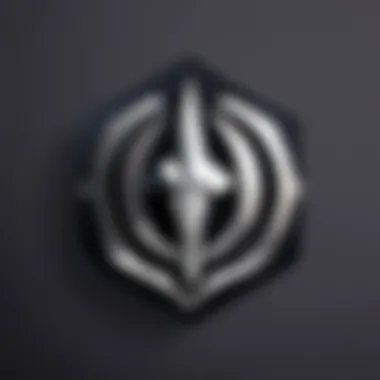Crafting a Logo for Free: The Ultimate Guide to Designing Your Own Brand Identity


Game Overview
In our detailed journey through the realm of logo design, we unravel the complexities and nuances of creating a captivating logo without delving into your wallet. This in-depth guide caters to individuals with an interest in graphic design and branding who seek to harness powerful visual elements without incurring costs. From immersing ourselves in online tools to grasping fundamental design principles, this guide equips readers with the essential knowledge to craft compelling logos without the burden of expenses.
Strategy Guides
Delve into the intricacies of logo creation as we unearth a plethora of tips and techniques for individuals, from novices to veterans, looking to embark on their logo design odyssey. Uncover beginner-friendly strategies that lay a solid foundation for designing logos and explore advanced tactics tailored for seasoned designers wanting to elevate their design prowess. Unravel map-specific strategies that enhance the visual appeal of your logo designs and uncover agent-specific tactics and playstyles that infuse uniqueness into your creations.
Patch Updates
Stay abreast of the dynamic landscape of logo design with a meticulous summarization of recent tool updates and features in the design space. Analyze the metamorphosis of design elements, from color schemes to logo components, driven by constant tool enhancements. Engage with the community's perspectives on logo design tool improvements, culminating in insightful predictions for upcoming updates that promise to revolutionize the logo design process.
Esports Coverage
Immerse yourself in a world where design meets competition as we navigate through the vibrant realm of esports events centered around visually appealing logos. Gain insights into recent emblem design tournaments, offering predictions and analysis on emerging logo design trends. Amass wisdom on the prevailing professional meta spawned by skilled designers, allowing you to calibrate your design strategies in alignment with cutting-edge industry standards.
Player Community
Celebrate the emblematic artwork of design enthusiasts, immersing yourself in a community-driven showcase highlighting the creative prowess of gifted designers. Witness the vibrant tapestry of logo-centric content created by impassioned designers, offering diverse perspectives and design techniques. Engage in discussions around trending design topics within the vivid forum spotlight to nurture a robust and interconnected logo design community.
Introduction
For anyone venturing into the realm of design, crafting a remarkable logo is more than an aesthetic endeavor; it is a cornerstone of brand identity and recognition. In this comprehensive guide on Creating a Logo for Free, we embark on a journey through the intricate world of graphic design. An effective logo is not just a visual representation but a powerful communicator of a brand's values, personality, and essence
Dive into the foundational principles that underpin successful logo design, encompassing color schemes, typography, and iconography. Understanding how these essential elements harmonize is crucial in creating a logo that resonates with the target audience. The symbiotic relationship between these facets can evoke emotions, convey messages, and leave a lasting impression.
Moreover, we decipher the psychology of colors within logo design, recognizing the profound impact different color palettes can have on consumer perception. Each hue carries intrinsic meanings, prompting varied emotional responses that can either elevate or hinder brand messaging. By harnessing the nuances of color psychology, designers can strategically wield colors to evoke desired reactions and associations.
Font selection transcends mere aesthetics; it plays a pivotal role in defining a brand's identity. Choosing the appropriate typeface is akin to selecting the right tone of voice for brand communication. The typography conveys personality traits, influences readability, and solidifies brand recognition. Delve into the nuances of selecting the right typeface to ensure your logo encapsulates the essence of your brand identity with finesse and distinction.


Understanding Logo Design
Logo design is a critical aspect of branding that plays a fundamental role in creating a visual identity for a company or a product. Understanding the intricacies of logo design is essential for crafting a logo that effectively communicates the values and essence of a brand. In this comprehensive guide to creating a logo for free, the section on Understanding Logo Design sheds light on the key elements and principles that go into designing a compelling logo.
Essential Elements of a Logo
A well-designed logo comprises several essential elements that work together to convey the intended message of a brand. These key components include the color scheme, typography, and iconography. Each element plays a crucial role in shaping the overall aesthetic and impact of the logo.
Color Scheme
The color scheme of a logo is pivotal as colors have the power to evoke emotions and convey specific messages. Selecting the right colors can enhance brand recognition and evoke desired psychological responses from the audience. In logo design, the color scheme is carefully chosen to align with the brand's personality and values, making it a crucial element in creating a memorable and impactful logo.
Typography
Typography in logo design involves the selection of fonts and the arrangement of text. The choice of typography can influence the perception of a brand, conveying different tones and visual styles. The right typography enhances readability and makes the logo visually appealing. It is essential to choose fonts that resonate with the brand's identity and target audience to ensure effective communication through the logo.
Iconography
Icons or symbols used in a logo can serve as visual representations of a brand's values or offerings. Iconography adds an extra layer of meaning to the logo, making it more visually engaging and memorable. When incorporated thoughtfully, icons can reinforce the brand message and create a strong visual association with the audience, contributing to the overall impact of the logo.
Psychology of Colors in Logo Design
The psychology of colors plays a significant role in logo design as different colors evoke distinct emotional responses and perceptions. Understanding how colors influence consumer behavior and brand perception is crucial in creating a logo that resonates with the target audience. By leveraging the psychological effects of colors, designers can craft logos that effectively communicate the intended brand message and elicit desired reactions.
Font Selection and Brand Identity
Font selection is a critical aspect of logo design, as typography plays a key role in shaping brand identity and visual appeal. Choosing the right typeface is essential to convey the brand's personality, values, and positioning effectively. The typeface selected for a logo should align with the brand's overarching identity and messaging strategy, ensuring coherence and consistency across all brand elements.
Exploring Free Logo Makers


In this section of the comprehensive guide on creating a logo for free, we delve into the crucial aspect of exploring free logo makers. The availability of online tools in today's digital age has revolutionized the way individuals and businesses approach logo design. By understanding the landscape of free logo makers, readers can harness these platforms to craft impactful and visually appealing logos without the need for substantial financial investment.
Overview of Online Logo Creation Platforms
- Canva: When discussing online logo creation platforms, Canva emerges as a standout choice for its user-friendly interface and extensive library of design assets. Canva offers a seamless experience for users, providing templates, graphics, and editing tools that simplify the logo design process. Its intuitive drag-and-drop functionality caters to both design novices and professionals, making it a versatile option for logo creation in this guide.
- LogoMakr: Another noteworthy platform in the realm of free logo makers is LogoMakr, known for its customization features and diverse design elements. LogoMakr empowers users to personalize their logos with unique icons, fonts, and color schemes, ensuring that each design remains distinctive and tailored to specific branding needs. The platform's flexibility and array of design options make it a valuable resource for creating professional logos without financial constraints.
- Looka: Lastly, Looka stands out as a popular choice for its AI-powered logo creation capabilities and premium design aesthetics. By leveraging artificial intelligence, Looka assists users in generating logo concepts based on their input and preferences, streamlining the design process significantly. The platform's focus on modern and stylish design solutions makes it a compelling option for individuals seeking high-quality logos at no cost.
Step-by-Step Guide to Using Free Logo Makers
- Creating an Account: Setting up an account on a free logo maker platform is a fundamental first step in the logo design journey. By registering on these platforms, users gain access to a plethora of design resources and tools that facilitate the creation process. Account creation also enables users to save their work, revisit designs, and collaborate with others seamlessly, enhancing the overall logo design experience.
- Choosing Templates: Selecting templates from a free logo maker platform serves as a starting point for logo customization. Templates provide users with pre-designed layouts that can be modified to align with brand aesthetics and messaging. By choosing templates that resonate with their vision, individuals can expedite the design process and experiment with various styles and formats to achieve the desired logo outcome.
- Customizing Designs: The ability to customize designs on free logo maker platforms offers users a wide range of creative possibilities. From adjusting colors and fonts to adding graphical elements and text, customization features empower users to tailor their logos to perfection. This hands-on approach to design customization allows for original and impactful logo creations that capture the essence of a brand effectively.
Tips for Designing a Memorable Logo
In the realm of logo design, crafting a logo that resonates with audiences is paramount. The section on Tips for Designing a Memorable Logo delves into the crucial aspects that contribute to creating a lasting impression. Emphasizing simplicity and versatility, this section sheds light on key strategies for impactful logo design. By embodying these principles, designers can enhance brand recognition and establish a strong visual identity. Furthermore, by understanding the significance of a memorable logo, businesses can effectively communicate their values and offerings to their target audience.
Simplicity and Versatility
Avoiding Overly Complex Designs
The focus on Avoiding Overly Complex Designs underscores the fundamental principle that less is often more in the world of logo design. By steering clear of intricate elements and convoluted compositions, designers can ensure clarity and coherence in their logos. Simplicity not only enhances aesthetic appeal but also aids in easy recognition and memorability. Embracing streamlined designs allows logos to transcend language barriers and cultural differences, making them universally comprehensible. This approach increases the likelihood of creating a logo that captivates audiences across diverse demographics and appeals to a broader spectrum of consumers.
Scalability and Adaptability
Ensuring Clear Reproduction Across Different Platforms
The significance of Ensuring Clear Reproduction Across Different Platforms lies in the ability of a logo to maintain its integrity and visual impact across various mediums. Logos designed with scalability and adaptability in mind can seamlessly transition from digital to print applications without losing quality or legibility. This ensures that the logo retains its essence regardless of size or format, preserving brand consistency and professionalism. By prioritizing adaptability, designers future-proof their logos, allowing them to remain relevant and effective amidst evolving technological landscapes and marketing trends.
Uniqueness and Originality
Standing Out in a Crowded Market


Standing Out in a Crowded Market is pivotal for a logo to carve a niche for itself amidst fierce competition. By infusing uniqueness and originality into design concepts, logos can differentiate themselves from rivals and leave a lasting impression on consumers. Original logos not only attract attention but also evoke positive associations and foster brand loyalty. By showcasing distinct brand personality and values, logos can establish an emotional connection with consumers, enhancing brand affinity and trust. Prioritizing uniqueness sets logos apart in saturated markets, helping businesses gain a competitive edge and assert their presence in the industry.
Finalizing Your Free Logo
In the realm of logo design, the finalization stage holds paramount significance to ensure the visual representation accurately resonates with the brand essence. Finalizing Your Free Logo is a crucial component in the process as it encapsulates the culmination of choices made during design. At this juncture, attention to detail is pivotal to guarantee the logo reflects the intended message effectively. Feedback plays a pivotal role in refining the logo to perfection, making this stage indispensable. Iteration allows for tweaks and adjustments based on constructive criticisms, enhancing the logo's impact and relevance. Considering the competitive business landscape, a finalized logo serves as a brand's visual identity, anchoring it in the minds of the target audience, fostering brand recognition and loyalty. The final logo acts as a seal of authenticity, embodying the brand's values and differentiating it from competitors.
Feedback and Iteration
Seeking Input from Peers
The process of Seeking Input from Peers accentuates the collaborative aspect of logo design, fostering a creative dialogue to enrich the final outcome. Peers provide fresh perspectives and constructive criticism, offering valuable insights that might escape the designer’s initial scrutiny. This approach promotes a more holistic evaluation of the logo's effectiveness and appeal, ensuring it resonates with a wider audience beyond the designer's subjective viewpoint. Furthermore, Seeking Input from Peers cultivates a sense of camaraderie and shared ownership of the design process, instilling confidence in the final product. While diversity in opinions may sometimes pose challenges, the amalgamation of varied viewpoints often leads to innovative solutions and a more refined logo design, making it a beneficial choice in the collaborative endeavor.
Refining Design Elements
Refining Design Elements involves meticulous fine-tuning to achieve a harmonious and cohesive visual identity for the logo. This process enables designers to reconsider design choices, adjust elements for better synergy, and ensure consistency across all components. By refining design elements, designers can enhance readability, scalability, and aesthetic appeal, elevating the logo's overall impact and memorability. The iterative nature of this phase allows for gradual improvements, addressing shortcomings, and optimizing the logo's visual communication to align with brand identity. While the refinement process demands attention to detail and continuous evaluation, it greatly contributes to the evolution of the logo into a powerful symbol that encapsulates the brand's essence succinctly.
Exporting and Implementing Your Logo
File Formats for Different Use Cases
Choosing the appropriate File Formats for Different Use Cases is crucial to ensure the logo maintains its visual integrity across various platforms and applications. Different formats cater to specific requirements, such as web display, print media, or merchandise, and understanding these variations is essential for seamless integration. Optimal file formats guarantee sharpness, clarity, and color accuracy when scaled or reproduced, preserving the logo's original quality. By selecting the right file formats, designers can prevent distortion, pixilation, or color discrepancies, providing a consistent visual identity for the brand across diverse marketing channels. Flexibility in file formats also facilitates easy sharing, editing, and collaboration, streamlining the logo implementation process effectively.
Application on Various Marketing Collaterals
Implementing the logo on Various Marketing Collaterals is a strategic initiative to enhance brand visibility and recognition across different touchpoints. The application of the logo on marketing materials, such as business cards, websites, promotional merchandise, and social media platforms, amplifies brand presence and fosters brand recall among the target audience. Each collateral requires unique considerations, such as size, placement, and color scheme, to harmonize the logo with the overall design aesthetic. By adapting the logo for diverse collaterals, designers ensure a seamless brand experience that reinforces brand credibility and fosters customer engagement. The strategic application of the logo on marketing collaterals is instrumental in establishing a consistent brand image that resonates with the brand's identity and values.
Conclusion
In the realm of logo design, the conclusion marks a crucial juncture where all the design elements and considerations coalesce into a unified brand representation. This section serves as the final touchpoint where the culmination of creativity and strategic thinking meets. The importance of the conclusion lies in its ability to encapsulate the essence of the brand visually and thematically. By synthesizing the different aspects discussed throughout this comprehensive guide, the conclusion ensures that the logo not only resonates with the target audience but also conveys the brand's values and identity succinctly.
When crafting a logo, the conclusion acts as the ultimate stage for refinement and validation. Seeking feedback from peers at this stage is paramount as it provides diverse perspectives that can refine the design further. Iterating based on constructive criticism refines the logo until it reaches its optimal form. Additionally, the conclusion delves into the practical aspects of logo design by focusing on exporting the final design in various file formats to ensure seamless applications across different marketing channels.
The conclusion also plays a pivotal role in establishing the logo's adaptability and scalability. By ensuring clear reproduction across different platforms, the conclusion guarantees that the logo maintains its integrity regardless of the medium it is displayed on. This adaptability reinforces the logo's versatility, ensuring it can be seamlessly integrated into a wide array of marketing collateral without losing its impact or visual appeal.
In essence, the conclusion of the logo design process encapsulates the brand's visual identity, communicating its core values and uniqueness effectively. It serves as a testament to the meticulous attention to detail and creative vision invested in crafting a compelling logo that not only captures attention but also leaves a lasting impression on the audience. This definitive stage marks the fruition of the logo design journey, symbolizing the brand's aspirations and setting the foundation for a strong visual presence in the competitive market.



